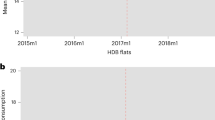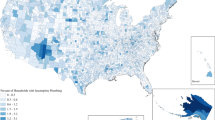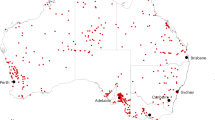Abstract
In this paper, we investigate two solutions to urban water security challenges: plumbing and nudging. Using anonymized monthly billing data from 1.5 million accounts in Singapore over ten years, our staggered difference-in-differences estimates show that a nationwide Home Improvement Programme that improves the efficiency of plumbing reduces residential water consumption by 3.5%. This effect persists over a decade and is robust across population subgroups. Efficiency improvements could enhance the efficacy of other conservation polices and mitigate the effects of excessive heat, rainfall and air pollution. The savings from efficiency improvements on utility bills are small, but the increase in housing value exceeds the private cost of the Home Improvement Programme. However, an evaluation of a nationwide peer-comparison nudging programme finds no evidence of reduced water consumption. Overall, we show that plumbing improvements generate long-lasting effects on water conservation.
This is a preview of subscription content, access via your institution
Access options
Access Nature and 54 other Nature Portfolio journals
Get Nature+, our best-value online-access subscription
$29.99 / 30 days
cancel any time
Subscribe to this journal
Receive 12 digital issues and online access to articles
$119.00 per year
only $9.92 per issue
Buy this article
- Purchase on Springer Link
- Instant access to full article PDF
Prices may be subject to local taxes which are calculated during checkout







Similar content being viewed by others
Data availability
The water consumption dataset for this study is provided by PUB, Singapore’s National Water Agency, under a non-disclosure agreement for the current study. Upon reasonable request to PUB and with the necessary non-disclosure agreements signed with NUS, the dataset is available onsite at NUS to replicate all the results from the deposited Stata code. The data on block-level housing characteristics, block-level demographics, weather, air pollution and HDB resale transactions are provided on GitHub: https://github.com/fmsgp/DataCode-HIP.git. Information on block-level housing characteristics, such as year of construction, HIP status and public rental status, was obtained from https://services2.hdb.gov.sg/web/fi10/emap.html, while block-level private rental information was obtained from https://www.srx.com.sg/hdb/. Block-level demographic data were processed from administrative records. Weather and air pollution records were retrieved from http://www.weather.gov.sg/climate-historical-daily/ and https://www.haze.gov.sg/resources/historical-readings, respectively. HDB resale transactions were collected through https://services2.hdb.gov.sg/web/fi10/emap.html. Source data are provided with this paper.
Code availability
The Stata code used for data analysis in this study is available on GitHub: https://github.com/fmsgp/DataCode-HIP.git.
References
Allcott, H. & Greenstone, M. Is there an energy efficiency gap? J. Econ. Perspect. 26, 3–28 (2012).
Gillingham, K., Keyes, A. & Palmer, K. Advances in evaluating energy efficiency policies and programs. Annu. Rev. Resour. Econ. 10, 511–532 (2018).
Graff Zivin, J. & Novan, K. Upgrading efficiency and behavior: electricity savings from residential weatherization programs. Energy J. 37, 1–23 (2016).
Allcott, H. & Greenstone, M. Measuring the Welfare Effects of Residential Energy Efficiency Programs Working Paper No. 23386 (NBER, 2017); https://doi.org/10.3386/w23386
Fowlie, M., Greenstone, M. & Wolfram, C. Do energy efficiency investments deliver? Evidence from the weatherization assistance program. Q. J. Econ. 133, 1597–1644 (2018).
Liang, J. et al. Do energy retrofits work? Evidence from commercial and residential buildings in Phoenix. J. Environ. Econ. Manage. 92, 726–743 (2018).
Davis, L. W., Fuchs, A. & Gertler, P. Cash for Coolers: evaluating a large-scale appliance replacement program in Mexico. Am. Econ. J. Econ. Policy 6, 207–238 (2014).
Jacobsen, G. D. & Kotchen, M. J. Are building codes effective at saving energy? Evidence from residential billing data in Florida. Rev. Econ. Stat. 95, 34–49 (2013).
Levinson, A. How much energy do building energy codes save? Evidence from California houses. Am. Econ. Rev. 106, 2867–2894 (2016).
Qiu, Y. & Kahn, M. E. Better sustainability assessment of green buildings with high-frequency data. Nat. Sustain. 1, 642–649 (2018).
Novan, K., Smith, A. & Zhou, T. Residential building codes do save energy: evidence from hourly smart-meter data. Rev. Econ. Stat. https://doi.org/10.1162/rest_a_00967 (2020).
Kotchen, M. J. Longer-run evidence on whether building energy codes reduce residential energy consumption. J. Assoc. Environ. Resour. Econ. 4, 135–153 (2017).
Mayer, P. W., DeOreo, W. B., Towler, E. & Lewis, D. M. Residential Indoor Water Conservation Study: Evaluation of High Efficiency Indoor Plumbing Fixture Retrofits in Single-Family Homes in the East Bay Municipal Utility District Service Area, Aquacraft, Inc. Water Engineering and Management (2003).
Water-Efficient Plumbing Fixtures Reduce Water Consumption and Wastewater Flows (United States General Accounting Office, 2000); https://www.gao.gov/assets/rced-00-232.pdf
Residential End Uses of Water (Water Research Foundation, 2016); https://www.circleofblue.org/wp-content/uploads/2016/04/WRF_REU2016.pdf
Price, J. I., Chermak, J. M. & Felardo, J. Low-flow appliances and household water demand: an evaluation of demand-side management policy in Albuquerque, New Mexico. J. Environ. Manage. 133, 37–44 (2014).
Bennear, L. S., Lee, J. M. & Taylor, L. O. Municipal rebate programs for environmental retrofits: an evaluation of additionality and cost-effectiveness. J. Policy Anal. Manage. 32, 350–372 (2013).
Allcott, H. Social norms and energy conservation. J. Public Econ. 95, 1082–1095 (2011).
Brent, D. A., Cook, J. H. & Olsen, S. Social comparisons, household water use, and participation in utility conservation programs: evidence from three randomized trials. J. Assoc. Environ. Resour. Econ. 2, 597–627 (2015).
Jessoe, K., Lade, G. E., Loge, F. & Spang, E. Spillovers from behavioral interventions: experimental evidence from water and energy use. J. Assoc. Environ. Resour. Econ. 8, 315–346 (2021).
Andor, M. A. & Fels, K. M. Behavioral economics and energy conservation—a systematic review of non-price interventions and their causal effects. Ecol. Econ. 148, 178–210 (2018).
Ferraro, P. J., Miranda, J. J. & Price, M. K. The persistence of treatment effects with norm-based policy instruments: evidence from a randomized environmental policy experiment. Am. Econ. Rev. 101, 318–322 (2011).
Bernedo, M., Ferraro, P. J. & Price, M. The persistent impacts of norm-based messaging and their implications for water conservation. J. Consum. Policy 37, 437–452 (2014).
Ferraro, P. J. & Price, M. K. Using nonpecuniary strategies to influence behavior: evidence from a large-scale field experiment. Rev. Econ. Stat. 95, 64–73 (2013).
Allcott, H. & Rogers, T. The short-run and long-run effects of behavioral interventions: experimental evidence from energy conservation. Am. Econ. Rev. 104, 3003–3037 (2014).
Newell, R. G. & Siikamäki, J. Nudging energy efficiency behavior: the role of information labels. J. Assoc. Environ. Resour. Econ. 1, 555–598 (2014).
Gilbert, B. & Graff Zivin, J. Dynamic salience with intermittent billing: evidence from smart electricity meters. J. Econ. Behav. Organ. 107, 176–190 (2014).
Jessoe, K. & Rapson, D. Knowledge is (less) power: experimental evidence from residential energy use. Am. Econ. Rev. 104, 1417–1438 (2014).
Wichman, C. J. Information provision and consumer behavior: a natural experiment in billing frequency. J. Public Econ. 152, 13–33 (2017).
Costa, D. L. & Kahn, M. E. Energy conservation ‘nudges’ and environmentalist ideology: evidence from a randomized residential electricity field experiment. J. Eur. Econ. Assoc. 11, 680–702 (2013).
Allcott, H. & Kessler, J. B. The welfare effects of nudges: a case study of energy use social comparisons. Am. Econ. J. Appl. Econ. 11, 236–276 (2019).
Sunstein, C. R. The distributional effects of nudges. Nat. Hum. Behav. https://doi.org/10.1038/s41562-021-01236-z (2021).
Allcott, H. Site selection bias in program evaluation. Q. J. Econ. 130, 1117–1165 (2015).
Nudges that don’t nudge. Nat. Hum. Behav. 4, 121 (2020).
WaterSense (United States Environmental Protection Agency, 2021); https://www.epa.gov/watersense/watersense-products
Hanna, R., Duflo, E. & Greenstone, M. Up in smoke: the influence of household behavior on the long-run impact of improved cooking stoves. Am. Econ. J. Econ. Policy 8, 80–114 (2016).
Mideksa, T. K. & Kallbekken, S. The impact of climate change on the electricity market: a review. Energy Policy 38, 3579–3585 (2010).
Deschênes, O. & Greenstone, M. Climate change, mortality, and adaptation: evidence from annual fluctuations in weather in the US. Am. Econ. J. Appl. Econ. 3, 152–185 (2011).
Agarwal, S., Sing, T. F. & Yang, Y. The impact of transboundary haze pollution on household utilities consumption. Energy Econ. 85, 104591 (2020).
Schultz, P. W., Nolan, J. M., Cialdini, R. B., Goldstein, N. J. & Griskevicius, V. The constructive, destructive, and reconstructive power of social norms. Psychol. Sci. 18, 429–434 (2007).
Brent, D. A. et al. What causes heterogeneous responses to social comparison messages for water conservation? Environ. Resour. Econ. 77, 503–537 (2020).
Agarwal, S., Rengarajan, S., Sing, T. F. & Yang, Y. Nudges from school children and electricity conservation: evidence from the ‘Project Carbon Zero’ campaign in Singapore. Energy Econ. 61, 29–41 (2017).
Acknowledgements
All the authors acknowledge the funding and water consumption data support from PUB, Singapore’s National Water Agency. The funder had no role in study design, data analysis, decision to publish or preparation of the manuscript.
Author information
Authors and Affiliations
Contributions
All authors contributed to the research design, implementation, data analysis and writing.
Corresponding author
Ethics declarations
Competing interests
The authors declare no competing interests.
Peer review
Peer review information
Nature Human Behaviour thanks Casey Wichman and the other, anonymous, reviewer(s) for their contribution to the peer review of this work. Peer reviewer reports are available.
Additional information
Publisher’s note Springer Nature remains neutral with regard to jurisdictional claims in published maps and institutional affiliations.
Extended data
Extended Data Fig. 1 Map of HDB blocks by HIP status.
The map shows the location of all HDB blocks in Singapore. The blue circles represent 2,262 HDB blocks that completed HIP by December 2019; the grey circles represent 3,342 HDB blocks that qualify for HIP but did not go through or complete the upgrade by December 2019. Out of which 1,777 blocks qualify for the initial program (that is, built before 1986) and 1,565 blocks qualify for the expansion (that is, built between 1986 and 1997); the black circles represent 4,586 HDB blocks that do not qualify for HIP (that is, built after 1997). The base map used is available at: https://data.gov.sg/dataset/master-plan-2019-subzone-boundary-no-sea.
Extended Data Fig. 2 Distribution of HDB flats by HIP cohort.
The figure shows the number of HDB flats in each region (Central, East, North, Northeast, and West) by year of HIP completion. Projects are considered complete 18 months after the announcement of a successful poll. The total number of flats that has completed HIP by December 2019 is 359,496.
Extended Data Fig. 3 Flat and household characteristics for HIP vs Non-HIP flats.
The figures show the distribution and mean of flat size (sub-figure (a)), flat age (sub-figure (b)), family size (sub-figure (c)), proportion of male (sub-figure (d)), proportion of Chinese (sub-figure (e)), proportion of elderly (sub-figure (f)) and proportion of young adults (sub-figure (g)) for HIP and non-HIP flats. The boxes represent the 25th to 75th percentile and the white lines inside represent medians; the error bars show the non-outlier limits, which are 1.5 times the interquartile range. The blue circles show the outliers while the green circles represent the sample mean. In our baseline sample, there are a total of 359,496 HIP flats and 1,143,854 non-HIP flats.
Extended Data Fig. 4 Flat and household characteristics by HIP cohort.
The figures show the mean and 95% confidence intervals for flat size (sub-figure (a)), flat age (sub-figure (b)), family size (sub-figure (c)), percentage of male (sub-figure (d)), percentage of Chinese (sub-figure (e)), percentage of elderly (sub-figure (f)) and percentage of young adults (sub-figure (g)) for HIP flats by cohort. The number of HIP flats by cohort are 9,426, 11,755, 13,525, 34,331, 7,061, 54,864, 38,563, 39,542, 84,413, 24,001, and 42,639 for project completion from 2009 to 2019, respectively. Detailed estimates are provided in Source Data Extended Data Figure. 4.
Extended Data Fig. 5 Number of housing transactions around the time of HIP completion.
The figure shows the number of HDB resale transactions each month, the linear trends and 95% confidence intervals before and after HIP completion. There is a total of 18,160 transactions within 24 months before and after HIP completion, out of which 8,719 transactions are pre-HIP and 9,441 post-HIP. The vertical line indicates the time of HIP completion defined as 18-month post the announcement of a successful poll.
Extended Data Fig. 6 Event study by year of HIP completion.
Extended Data Fig. 1 The figures show the estimated coefficients and corresponding 95% confidence intervals (error bars) for the effect of HIP in each 12-month period after project completion for each HIP cohort by estimating equation 3. The number of observations used for are 936,619 (sub-figure (a)), 2,327,234 (sub-figure (b)), 490,385(sub-figure (c)), 3,705,615 (sub-figure (d)), 2,632,263 (sub-figure (e)), 2,735,076 (sub-figure (f)), 5,841,537 (sub-figure (g)), and 1,645,165 (sub-figure (h)), respectively. Detailed estimates are provided in Source Data Extended Data Figure. 6. The vertical lines indicate the time of HIP completion defined as 18-month post the announcement of a successful poll.
Extended Data Fig. 7 Distribution, trend and spatial variation in temperature, rainfall, and air pollution.
The figures show the distribution, trend, and spatial variation (in terms of standard deviation) in monthly mean temperature (sub-figure (a)), number of rainy days (sub-figure (b)), and PSI (sub-figure (c)) from January 2011 to December 2019 using the baseline sample of 98,291,320 observations.
Extended Data Fig. 8 Event study for peer comparison by month.
This figure shows the estimated coefficients and corresponding 95% confidence intervals (error bars) for the effect of nudging through peer comparison in each month for the first year after its implementation by estimating equation 10 using the baseline sample of 98,291,320 observations. Detailed estimates are provided in Source Data Extended Data Figure. 9. The vertical lines from left to right indicate the timing of nudging, drought, and the announcement of water price increase.
Extended Data Fig. 9 Regression discontinuity around national and neighbourhood average.
The figures show the monthly water consumption by the distance to neighbourhood mean for households who consume below (sub-figure (a)) and above (sub-figure (b)) the national mean; and by the distance to national mean for households who consume below (sub-figure (c)) and above (sub-figure (d)) the neighbourhood mean. Monthly water consumption variable is residual of account fixed effects, year-month fixed effects, and weather and pollution controls. The average residual water consumptions below the cut-offs (distance<0) are shown in black dots and above the cut-offs (distance>0) are shown in blue dots. The fitted lines from robust locally weighted regressions below the cut-offs (distance<0) are shown in green and above the cut-offs (distance>0) are shown in yellow.
Supplementary information
Supplementary Information
Supplementary Discussion, Figs. 1–10 and Tables 1–15.
Source data
Source Data Fig. 1
Statistical source data.
Source Data Fig. 2
Statistical source data.
Source Data Fig. 3
Statistical source data.
Source Data Fig. 4
Statistical source data.
Source Data Fig. 5
Statistical source data.
Source Data Fig. 6
Statistical source data.
Source Data Fig. 7
Statistical source data.
Source Data Extended Data Fig. 2
Statistical source data.
Source Data Extended Data Fig. 3
Statistical source data.
Source Data Extended Data Fig. 4
Statistical source data.
Source Data Extended Data Fig. 5
Statistical source data.
Source Data Extended Data Fig. 6
Statistical source data.
Source Data Extended Data Fig. 7
Statistical source data.
Source Data Extended Data Fig. 8
Statistical source data.
Source Data Extended Data Fig. 9
Statistical source data.
Rights and permissions
About this article
Cite this article
Agarwal, S., Araral, E., Fan, M. et al. Water conservation through plumbing and nudging. Nat Hum Behav 6, 858–867 (2022). https://doi.org/10.1038/s41562-022-01320-y
Received:
Accepted:
Published:
Issue Date:
DOI: https://doi.org/10.1038/s41562-022-01320-y
This article is cited by
-
The effects of policy announcement, prices and subsidies on water consumption
Nature Water (2023)
-
How to save water: plumbing can be changed but people can’t
Nature (2022)



